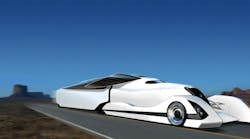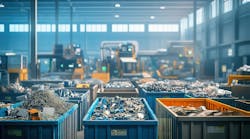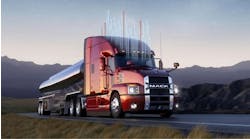Over the past few years, Wade & Patners has had the opportunity to work on emerging technologies being developed at several of the nation's top university think-tanks and incubators. Based on things we have seen, plus our own research, here is a look at what can be expected with regard to heavy duty truck technology as we progress to the year 2020.
To begin, fuel and energy are the wildcards in trucking's future. While natural gas is gaining a lot of attention, electrics and co-powered diesel electric is still a consensus favorite.
For the next 10 or so years, the purchase price of an electrified vehicle will probably exceed the price of diesel-fueled commercial models by thousands of dollars. This difference is due largely to the cost of designing vehicles that can drive for extended distances on battery power and to the cost of the battery itself.
The infrastructure for charging the batteries of a large number of electrified vehicles isn't in place, nor is the industry tooled to produce them on a mass scale. What's more, the distance electrified vehicles can go before recharging may undermine acceptance for all but domiciled fleets.
On a more fundamental level, electrified vehicles will go mainstream at a pace determined by government action: making diesel more expensive; reducing the cost of producing, buying or operating electrified vehicles; or some combination of these two approaches.
As for trucks, even conservative futurists are betting on interference by government. They feel concern over energy security, fossil fuel emissions and long-term industrial competitiveness will prompt governments to seek a partial solution by creating incentives - some combination of subsidies, taxes and investments - to migrate the market to battery-powered vehicles.
Electrified vehicles can already address certain niches whose economics could be favorable more quickly, such as bus, delivery and taxi fleets in large cities. Military fleets may lead the way.
TRUCK OEMs REINVENT THEIR BUSINESSES
From a practical business standpoint, electrified vehicles pose an enormous threat to incumbent truck OEMs. The internal-combustion engine and transmission are the core components they have focused on, while outsourcing the manufacture of many other components and subassemblies.
In a world where vehicles run on electrons rather than hydrocarbons, the OEMs will have to reinvent their businesses to survive. Nonetheless, incumbency is also a strategic strength in this sector. New technology "attackers" face significant entry barriers, including:
- Manufacturing scale (including engineering prowess).
- End user brand equity (now worldwide).
- Channel relationships (suppliers as well as dealership networks).
- Customer relationship management and market research.
Truck makers could beat attackers to the punch in tapping assets, such as plants and dealership networks, to introduce new business models, such as selling transport services rather than products.
OEMs will also need to think about whether dealers like Rush Truck Centers - North America's largest network of heavy and medium duty truck dealerships - or aftermarket players like FleetPride – America's premier nationwide supplier of heavy duty truck and trailer parts - will sell or lease battery packs.
The key question is whether these new technologies can be scaled. If they can, today's constraints on biofuels - the declining quality of available land and "food for fuel" trade-offs - may diminish.
MAIN AREAS OF ADVANCEMENT
To be sure, the heavy duty truck of 2020 will be a marvel that only slightly resembles today's big iron. While trying to predict progress in the large number of components and functions that make up heavy trucks would burn out any crystal ball, here is an overall prognostication of the blueprint of the interconnected technology advances to come in the next 7 to 10 years.
- Vehicle Electronics
+ Drive-by-wire to wireless control - Basically, this encompasses anything that eliminates mechanical or electrical (wire) actuation. Product lines affected include brake, steering and signal lighting actuation.
+ Engine and drivetrain control - "Unitized performance" is the mantra for engine and driveline designers to facilitate both fuel economy and driver compatibility.
+ Glass cockpit - More discrete reporting systems and more driver interface. Much like pilots, multi-function instruments with heads-up display are necessary to simplify some of the truck to driver communication.
- Materials and Coatings
+ Biofuels - Agricultural product and especially by-product based hydrocarbon sources are close to street ready now. Although second-generation cellulosic biofuels have proved harder to make than many had hoped five years ago, innovative start-ups focused on cellulosic and algae-based biofuels are starting to create high-margin specialty chemicals and blendstocks, generating cash now and suggesting biofuels at $2 a gallon or less by 2020.
+ Dual fuel engines - Similar in design to the Cummins Westport LNG/diesel solution being successfully marketed now, these hybrid engines could also benefit from ultra-high pressure injection (45,000 psi) to dampen emissions.
+ Biocoolants and lubricants - Biodegradable and non-toxic (and potentially cheaper) future antifreeze and greases will continue to turn away from petroleum-based cousins.
+ Ferromagnetic fluid, also known as magneto rheological (MR) fluids - These fluids, which change viscosity in the presence of electric current, will replace some hydraulic/pneumatic and friction functions in suspensions and drivetrain designs.
+ High strength-to-weight structural composites - Once again looking toward aircraft design for clues to future vehicle design, composites can make a huge contribution toward higher hauling capacity. Look for this especially in seamless trailer, cargo container and package car designs.
- Computers and Communications
+ GPS integration - Just in time (JIT) freight scheduling/notification, driver performance and drivers logs will be pushed to universal adoption by strict HOS and CSA regulation enforcement.
+ Transmission of onboard equipment parameters - Diagnostics and predictive maintenance data will be available to destination or current position service providers who are tied into fleet networks.
+ Shipping unit-level integrated logistics - Online pallet and container tracking will facilitate bypassing of central warehouses and cross-docks.
+ Cargo and vehicle security - Quickly declining systems costs will increase use of virtual yards - a technology that allows users to better manage equipment needs. Advanced real-time vehicle status will be quickly adopted, especially for carriers of high unit value consumer goods.
+ Real-time anything - Routing efficiency, traffic congestion, weather, tolls, weights, fuel consumption, driver performance and taxes will be done in actual time. This reporting availability will allow tolling based on time of day and exact gross vehicle weight.
- Increased Vehicle Safety
+ Driver collision protection - More heavy vehicles will incorporate safety features that have been standard in cars and light trucks for years. More cabs will include increased passive restraints (air bags). Soy-based foam for comfort and sound deadening is an example of the sustainability aspect in new designs.
+ Forward lighting - The ability to really provide enhanced forward lighting will increase as variable focus designs become popular. Advanced solutions such as bi-xenon designs (originally for the military) assure infinitely variable intensity and direction.
+ 360-degree obstacle and lane departure detection - A number of combinations of visual and ultrasonic, forward speed control and 360-degree collision avoidance devices are nearly road ready. This will be advanced further by new connected-vehicle technology.
+ Light emitting diode (LED) - Low energy drain, variable-intensity lighting in some form of LED, organic (OLED), polymer (PLED) or plasma has doomed incandescent to vehicle obsolesce.
- Aerodynamics and Rolling Resistance
+ Spoilers, boat-tails, fairings and skirts - Offering fuel economy increases of more than seven percent, these aerodynamic devices show results only in over-the-road application. Primarily aftermarket items today, nearly all will be OEM options soon. Vehicle control in high winds and maximized spray suppression may be a major benefit of new approaches.
+ Tires - Minimizing tire contact with the road already has been shown to increase fuel efficiency by about 0.5 MPG (around 6 percent). Coupled with the weight saving and smooth drivability, continued R&D investment by tire companies is assured.




